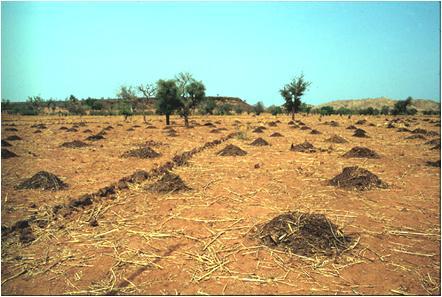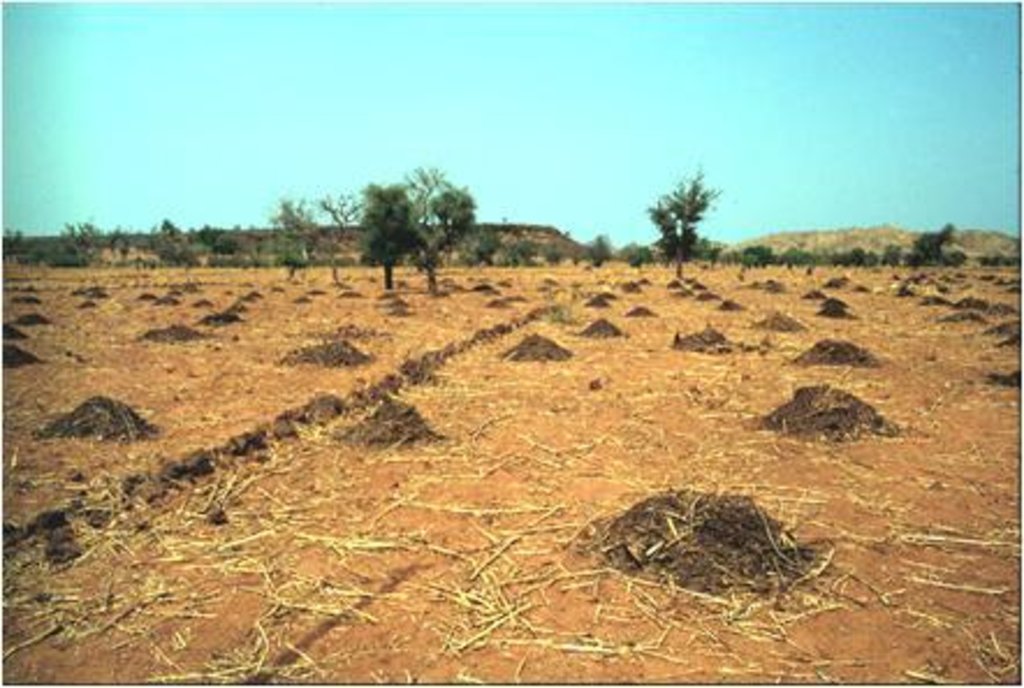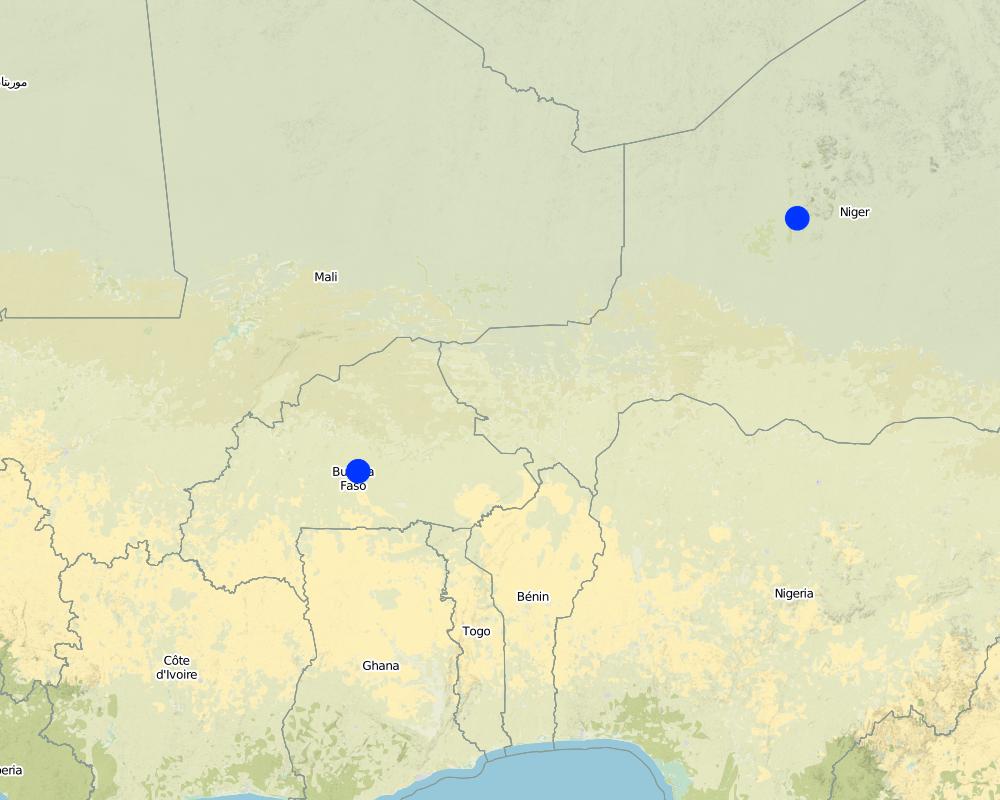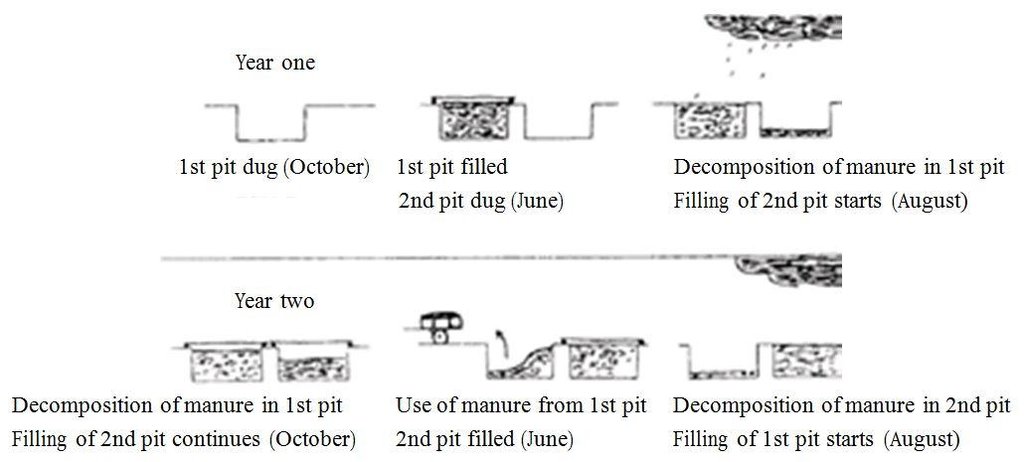Use of organic matter (manure and compost) [Burkina Faso]
- Creation:
- Update:
- Compiler: Dieter Nill
- Editor: –
- Reviewer: David Streiff
Apport de matière organique (French)
technologies_1220 - Burkina Faso
View sections
Expand all Collapse all1. General information
1.2 Contact details of resource persons and institutions involved in the assessment and documentation of the Technology
SLM specialist:
Dorlöchter-Sulser Sabine
Misereor
Germany
SLM specialist:
Sani Mamadou Abdou
mamadou.sani@giz.de
Programme d’Appui à l’agriculture Productive
Niamey
Niger
Name of project which facilitated the documentation/ evaluation of the Technology (if relevant)
Programme d’Appui à l’agriculture Productive (GIZ / PROMAP)Name of the institution(s) which facilitated the documentation/ evaluation of the Technology (if relevant)
Deutsche Gesellschaft für Internationale Zusammenarbeit (GIZ) - GermanyName of the institution(s) which facilitated the documentation/ evaluation of the Technology (if relevant)
Misereor - Germany1.3 Conditions regarding the use of data documented through WOCAT
When were the data compiled (in the field)?
01/07/2012
The compiler and key resource person(s) accept the conditions regarding the use of data documented through WOCAT:
Ja
1.4 Declaration on sustainability of the described Technology
Is the Technology described here problematic with regard to land degradation, so that it cannot be declared a sustainable land management technology?
Nee
2. Description of the SLM Technology
2.1 Short description of the Technology
Definition of the Technology:
Soils treated with compost or manure produce better yields, because they retain water better and are more fertile.
2.2 Detailed description of the Technology
Description:
The regular application of manure and/or compost in sufficient quantities makes farming more intensive and reduces the need to bring more land under cultivation. Manure is used on cropland and compost is recommended particularly for market gardening.
Purpose of the Technology: The use of organic matter on cropland has three major effects: it reactivates biological activity, increases soil fertility by providing nutrients and improves soil structure by increasing the amount of organic matter in it. The improved soil structure also increases the infiltration of water into the soil. These effects favour crop growth and increase yields. The denser vegetation and improved soil structure make the land more resistant to water and wind erosion.
Establishment / maintenance activities and inputs: There are two methods for obtaining organic matter for use as a fertiliser: the production of compost and the collection of manure. Manure is collected from improved livestock pens or sheds where livestock is kept on litter or bedding. Compost can be made in the dry season or in the rainy season. Biodegradable matter is mixed with animal waste for rapid decomposition or just with millet, sorghum or other plant stalks for slow decomposition. Both types of compost can be enriched with ash and/or natural phosphate. The biodegradable matter is placed in a pit. In the dry season, it is regularly sprinkled with water until decomposition is complete. It is then spread evenly over the land before sowing or planting.
Unlike compost, manure collected from improved pens or livestock sheds is not completely decomposed, and the decomposition process continues over several years.
The recommended amount varies depending on the type of soil the availability of manure and compost: 6 t/ha every third year (heavy clayey soils), 3t/ha every two years (sandy-clayey soils) or 2t/ha every year (light soils).
Natural / human environment: The use of compost and manure is recommended in conjunction with all other SWC/SPR measures to achieve the maximum benefit from investments in land improvement.
2.3 Photos of the Technology
2.5 Country/ region/ locations where the Technology has been applied and which are covered by this assessment
Country:
Burkina Faso
Region/ State/ Province:
Burkina Faso, Niger
Map
×2.6 Date of implementation
If precise year is not known, indicate approximate date:
- 10-50 years ago
2.7 Introduction of the Technology
Specify how the Technology was introduced:
- through projects/ external interventions
Comments (type of project, etc.):
Developed, implemented and disseminated as part of projects and programmes undertaken from the 1980s onwards to combat desertification and improve natural resource management. Implemented by GIZ (German Federal Enterprise for International Cooperation), PDRT (Projet de développement rural de Tahoua - Tahoua Rural Development Project), PASP (Projet de protection intégrée des ressources agro-sylvo-pastorales Tillabéri-Nord - Project for the Integrated Protection of Agricultural, Forest and Rangeland Resources in Tillabéri-Nord), and PATECORE (project for land development and resource conservation in Plateau Central Burkina Faso)
3. Classification of the SLM Technology
3.1 Main purpose(s) of the Technology
- improve production
- improve fertility
3.2 Current land use type(s) where the Technology is applied

Cropland
- Annual cropping
Comments:
Major land use problems (compiler’s opinion): low biological activity, low soil fertility, bad soil structure, low amount of organic matter, surface runoff, aridification, erosion by water and wind
Constraints of common grazing land
Constraints of forested government-owned land or commons
3.3 Further information about land use
Number of growing seasons per year:
- 1
Specify:
Longest growing period in days: 120; Longest growing period from month to month: August to October
3.4 SLM group to which the Technology belongs
- integrated soil fertility management
3.5 Spread of the Technology
Specify the spread of the Technology:
- evenly spread over an area
3.6 SLM measures comprising the Technology

agronomic measures
- A2: Organic matter/ soil fertility
Comments:
Type of agronomic measures: manure / compost / residues
3.7 Main types of land degradation addressed by the Technology

soil erosion by water
- Wt: loss of topsoil/ surface erosion

soil erosion by wind
- Et: loss of topsoil

chemical soil deterioration
- Cn: fertility decline and reduced organic matter content (not caused by erosion)

biological degradation
- Bq: quantity/ biomass decline
- Bl: loss of soil life

water degradation
- Ha: aridification
Comments:
Main causes of degradation: crop management (annual, perennial, tree/shrub) (Unadapted landuse methods, reduced or abandoned fallow periods), floods, droughts, population pressure (rapidly growing population increasing pressure on land), land tenure (insecure access to land)
3.8 Prevention, reduction, or restoration of land degradation
Specify the goal of the Technology with regard to land degradation:
- reduce land degradation
- restore/ rehabilitate severely degraded land
4. Technical specifications, implementation activities, inputs, and costs
4.1 Technical drawing of the Technology
4.2 Technical specifications/ explanations of technical drawing
Biodegradable matter is mixed with animal waste for rapid decomposition or just with millet, sorghum or other plant stalks for slow decomposition. The biodegradable matter is placed in a pit. In the dry season, it is regularly sprinkled with water until decomposition is complete. It is then spread evenly over the land before sowing or planting.
Technical knowledge required for field staff / advisors: moderate
Technical knowledge required for land users: low
Main technical functions: improvement of ground cover, improvement of surface structure (crusting, sealing), improvement of topsoil structure (compaction), increase in organic matter, increase in nutrient availability (supply, recycling,…), increase of infiltration, increase / maintain water stored in soil, increase of biomass (quantity), promotion of vegetation species and varieties (quality, eg palatable fodder)
Secondary technical functions: water harvesting / increase water supply, sediment retention / trapping, sediment harvesting, reduction in wind speed
Manure / compost / residues
Material/ species: Biodegradable matter, animal waste, plant stalks, ash and/or natural phosphate, manure collected
4.6 Maintenance/ recurrent activities
| Activity | Type of measure | Timing/ frequency | |
|---|---|---|---|
| 1. | Biodegradable matter is mixed with animal waste for rapid decomposition or just with millet, sorghum or other plant stalks for slow decomposition | Agronomic | |
| 2. | The biodegradable matter is placed in a pit. | Agronomic | |
| 3. | In the dry season, it is regularly sprinkled with water until decomposition is complete | Agronomic | |
| 4. | It is then spread evenly over the land before sowing or planting. | Agronomic |
4.7 Costs and inputs needed for maintenance/ recurrent activities (per year)
Comments:
Machinery/ tools: shovel, wheelbarrow, etc.
4.8 Most important factors affecting the costs
Describe the most determinate factors affecting the costs:
Production of compost:
• constructing pits or basins
• water
• equipment (shovel, wheelbarrow, etc.).
Use of compost:
• transportation to plot by cart (100 kg of manure per donkey cartload)
• transportation to plot in head baskets (20 kg of manure per basket)
• spreading the compost on the plot (labour).
5. Natural and human environment
5.1 Climate
Annual rainfall
- < 250 mm
- 251-500 mm
- 501-750 mm
- 751-1,000 mm
- 1,001-1,500 mm
- 1,501-2,000 mm
- 2,001-3,000 mm
- 3,001-4,000 mm
- > 4,000 mm
Agro-climatic zone
- semi-arid
Thermal climate class: subtropics
5.2 Topography
Slopes on average:
- flat (0-2%)
- gentle (3-5%)
- moderate (6-10%)
- rolling (11-15%)
- hilly (16-30%)
- steep (31-60%)
- very steep (>60%)
Landforms:
- plateau/plains
- ridges
- mountain slopes
- hill slopes
- footslopes
- valley floors
Altitudinal zone:
- 0-100 m a.s.l.
- 101-500 m a.s.l.
- 501-1,000 m a.s.l.
- 1,001-1,500 m a.s.l.
- 1,501-2,000 m a.s.l.
- 2,001-2,500 m a.s.l.
- 2,501-3,000 m a.s.l.
- 3,001-4,000 m a.s.l.
- > 4,000 m a.s.l.
5.3 Soils
Soil depth on average:
- very shallow (0-20 cm)
- shallow (21-50 cm)
- moderately deep (51-80 cm)
- deep (81-120 cm)
- very deep (> 120 cm)
Soil texture (topsoil):
- medium (loamy, silty)
- fine/ heavy (clay)
If available, attach full soil description or specify the available information, e.g. soil type, soil PH/ acidity, Cation Exchange Capacity, nitrogen, salinity etc.
Soil fertility is low - medium
Soil drainage / infiltration is poor - medium
Soil water storage capacity is low - medium
5.4 Water availability and quality
Ground water table:
5-50 m
Availability of surface water:
medium
Comments and further specifications on water quality and quantity:
Ground water table: > 10 m
Availability of surface water: Surface runoff generated by limited but intense rainfalls
5.5 Biodiversity
Species diversity:
- low
5.6 Characteristics of land users applying the Technology
Relative level of wealth:
- very poor
- poor
Gender:
- men
Indicate other relevant characteristics of the land users:
Population density: 10-50 persons/km2
Annual population growth: 3% - 4% (mostly poor households below poverty line).
Off-farm income specification: men migrate temporarily or permanently to cities for off-farm income
5.7 Average area of land owned or leased by land users applying the Technology
- < 0.5 ha
- 0.5-1 ha
- 1-2 ha
- 2-5 ha
- 5-15 ha
- 15-50 ha
- 50-100 ha
- 100-500 ha
- 500-1,000 ha
- 1,000-10,000 ha
- > 10,000 ha
Is this considered small-, medium- or large-scale (referring to local context)?
- small-scale
5.8 Land ownership, land use rights, and water use rights
Land ownership:
- state
Land use rights:
- communal (organized)
Water use rights:
- communal (organized)
Comments:
traditional land use rights on fields, communal land on pasture and forest land
5.9 Access to services and infrastructure
health:
- poor
- moderate
- good
education:
- poor
- moderate
- good
technical assistance:
- poor
- moderate
- good
employment (e.g. off-farm):
- poor
- moderate
- good
markets:
- poor
- moderate
- good
energy:
- poor
- moderate
- good
roads and transport:
- poor
- moderate
- good
drinking water and sanitation:
- poor
- moderate
- good
financial services:
- poor
- moderate
- good
6. Impacts and concluding statements
6.1 On-site impacts the Technology has shown
Socio-economic impacts
Production
crop production
Income and costs
expenses on agricultural inputs
farm income
workload
Socio-cultural impacts
food security/ self-sufficiency
SLM/ land degradation knowledge
livelihood and human well-being
Comments/ specify:
The use of compost and manure improves yields and output, thereby improving food security. The sale of surplus production also increases household income
Ecological impacts
Water cycle/ runoff
harvesting/ collection of water
surface runoff
Soil
soil moisture
soil cover
soil loss
soil crusting/ sealing
nutrient cycling/ recharge
Biodiversity: vegetation, animals
biomass/ above ground C
pest/ disease control
Comments/ specify:
The use of partially decomposed manure also exposes crops to certain pests and to the risk of being scorched
Climate and disaster risk reduction
wind velocity
6.2 Off-site impacts the Technology has shown
downstream flooding
downstream siltation
wind transported sediments
6.3 Exposure and sensitivity of the Technology to gradual climate change and climate-related extremes/ disasters (as perceived by land users)
Gradual climate change
Gradual climate change
| Season | Type of climatic change/ extreme | How does the Technology cope with it? | |
|---|---|---|---|
| annual temperature | increase | well |
Climate-related extremes (disasters)
Meteorological disasters
| How does the Technology cope with it? | |
|---|---|
| local rainstorm | not well |
| local windstorm | well |
Climatological disasters
| How does the Technology cope with it? | |
|---|---|
| drought | well |
Hydrological disasters
| How does the Technology cope with it? | |
|---|---|
| general (river) flood | not well |
Other climate-related consequences
Other climate-related consequences
| How does the Technology cope with it? | |
|---|---|
| reduced growing period | well |
6.4 Cost-benefit analysis
How do the benefits compare with the establishment costs (from land users’ perspective)?
Short-term returns:
positive
Long-term returns:
very positive
How do the benefits compare with the maintenance/ recurrent costs (from land users' perspective)?
Short-term returns:
very positive
Long-term returns:
very positive
6.5 Adoption of the Technology
Comments:
There is a little trend towards spontaneous adoption of the Technology
Comments on adoption trend: transporting manure and compost poses a major hurdle for poor farmers who do not have a cart. This is a particularly serious problem when plots are at a distance from the village (outfields)
6.7 Strengths/ advantages/ opportunities of the Technology
| Strengths/ advantages/ opportunities in the compiler’s or other key resource person’s view |
|---|
| reactivates biological activity, increases soil fertility by providing nutrients and improves soil structure by increasing the amount of organic matter in it |
| The improved soil structure also increases the infiltration of water into the soil |
| The use of compost and manure improves yields and output, thereby improving food security. The sale of surplus production also increases household income. |
| The denser vegetation and improved soil structure make the land more resistant to water and wind erosion. |
6.8 Weaknesses/ disadvantages/ risks of the Technology and ways of overcoming them
| Weaknesses/ disadvantages/ risks in the compiler’s or other key resource person’s view | How can they be overcome? |
|---|---|
| Manure and compost are often not available in sufficient quantities | In spite of these drawbacks, manure is the form of fertilisation most commonly used by farmers, as it requires less work than compost. |
| Water is required to moisten compost during the dry season in order to ensure that it is kept at the right temperature for the decomposition of the biomass | |
| transporting manure and compost poses a major hurdle for poor farmers who do not have a cart. This is a particularly serious problem when plots are at a distance from the village (outfields). | |
| farmers are deterred from composting in the dry season because a nearby supply of water is needed and it involves a considerable amount of work | |
| The use of manure on farmland entails some risks and disadvantages. As the manure is only partially decomposed – decomposition starts after the first rains begin – crops do not have enough nitrogen for a time. The use of partially decomposed manure also exposes crops to certain pests and to the risk of being scorched. |
7. References and links
7.1 Methods/ sources of information
- field visits, field surveys
- interviews with land users
7.2 References to available publications
Title, author, year, ISBN:
Good Practices in Soil and Water Conservation. A contribution to adaptation and farmers´ resilience towards climate change in the Sahel. Published by GIZ in 2012.
Available from where? Costs?
http://agriwaterpedia.info/wiki/Main_Page
Links and modules
Expand all Collapse allLinks
No links
Modules
No modules





